Uno spazio dentro lo spazio, una superficie di 25 mq, quasi 150 tra poster e oggetti raccolti in quindici anni, un bar pubblico aperto un giorno a settimana. Cafe Hansi è l’ultimo progetto di Hans Schabus esposto alla Kerstin Engholm Gallery di Vienna, in occasione di Autopsie mit Hubwage.
Un grande spazio-scultura ospita al suo esterno declinazioni eterogenee del nome “Hans”, analogie e associazioni unificano e disperdono l’identità di un nome diffuso e poi quasi scomparso. L’interno è un bar, un “non luogo” neutro e specchiato dove l’artista serve il pubblico.
Hans Schabus conferma ed evolve il suo approccio conferendo valore allo spazio ottenuto dentro l’altro spazio, il possibile e il percorribile, con la meticolosa previsione di una scultura sociale performativa. Lungo un presente fatto di nuove e necessarie aggregazioni sociali il lavoro dell’artista austriaco sottolinea il rapporto tra un’individualità che vuole indagarsi e una socialità dentro la quale sciogliersi.
Francesco Lucifora: In Cafe Hansi una grande scultura e uno spazio fisico mostrano due aspetti, uno interno e l’altro esterno, nel quale un gran numero di materiali diversi recano il riferimento al nome Hans. Mi piacerebbe conoscere le ragioni per cui hai iniziato a raccogliere questi materiali e come si è evoluto questo processo di raccolta.

Hans Schabus: Hans è un nome ampiamente utilizzato in Austria. Sono cresciuto in campagna e c’era almeno un Hans in ogni famiglia. Dopo la mia generazione la diffusione di questo nome si è ridotta in modo considerevole e non è stato più utilizzato. Se si esegue una ricerca su Internet per il nome Hans vengono visualizzate soltanto persone anziane. Ci sono molte figure fittizie di Hans come ad esempio Eisenhans, HansDampf, Hänsel e Gretel, Hans Guck-in-die-Luft, Hanswurst, Hans im Glück, Hans lo sciocco, il pigro Hans, Hans il forte, Hans la spazzatura, il divertente Hans, etc. E se mi è stato dato questo nome dopo tutti questi diversi Hans allora divento parte di tutti loro. Questo ha un senso? Dunque io sono un po’ di tutto, sono la media di tutti i possibili Hans. Probabilmente, e ti rispondo, è per questo che ho dovuto iniziare molto tempo fa a raccogliere materiali con il mio nome: per scoprire qualcosa di me.
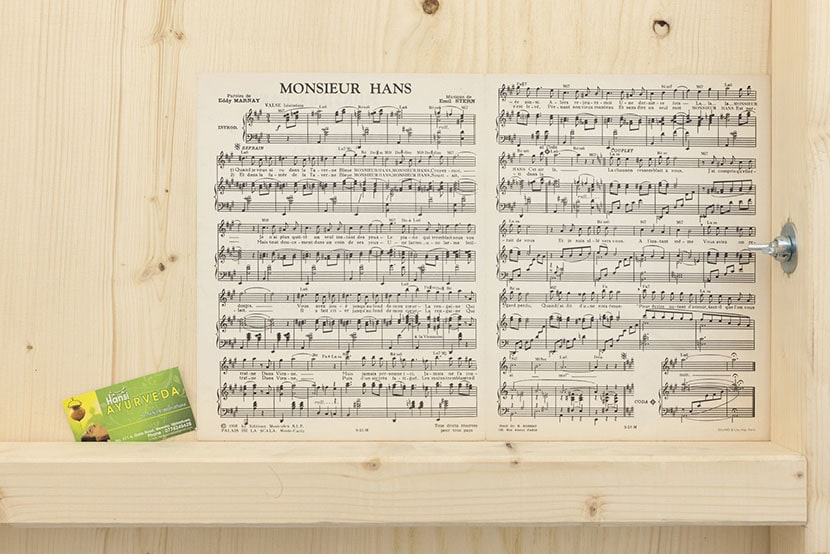
FL: Una parte rilevante delle tue opere riguarda il rapporto tra il lavoro in studio e la realtà esterna, per poi voler tornare nel tuo studio. Cafe Hansi appare come uno spostamento di questo percorso, un invito in uno spazio più sociale creato sulla tua identità e anche una moltiplicazione identitaria che tenta di risolvere l’ego come uno dei maggiori problemi dell’essere. Come sei arrivato a questo nuovo spazio scultoreo?
HS: Cafe Hansi risale a una mostra che ho fatto per Secession nel 2003. In quel caso ho costruito il volume del mio studio alla fine di un lungo tunnel. A causa di un ingresso murato i visitatori erano obbligati a passare al piano di sotto e dal seminterrato iniziava il tunnel che portava dentro lo studio. I visitatori potevano lasciare lo spazio e infine entrare nella sala principale di Secession e da lì osservare la parte posteriore del luogo che avevano appena attraversato.
In generale sono interessato a un approccio base alla scultura, sia che usi l’assemblaggio o l’estrazione, in entrambi i casi si dà origine a un volume. Ricordo l’aneddoto secondo il quale fu chiesto a Michelangelo come aveva creato le sculture dei leoni e lui rispose che stava semplicemente rimuovendo il blocco di marmo che non sembrava affatto un leone. Quello che mi interessa è questo pensiero al rovescio: lo spazio di ciò che manca diventa ciò che conta veramente e oltretutto anche la sua capacità di contenere persone. Ecco perché Cafe Hansi sta diventando una scultura sociale performativa.
FL: Il tuo modo di intendere la scultura contempla spesso la presenza di una dualità spaziale, vorrei sapere quali ragioni stanno dietro alla netta differenza tra l’interno e l’esterno1 di questo nuovo lavoro, l’esterno è pieno di segni, suoni, riferimenti e meccanismi di associazione relativi a Hans e l’interno è lineare, asettico e offre alle persone la possibilità di vedersi riflessi negli specchi. Leggo questo lavoro come un’espressione alta della relazione tra individuo e società. Mi piacerebbe chiederti di parlarmi ancora di questo.
HS: Lo spazio espositivo è attualmente diviso da una membrana, una struttura che consiste in un dentro e in un fuori. L’esterno espone tutto quello che è fisico, metaforico, referenziale, insieme ad altri materiali. L’interno è formato da una superficie lucida e dalla mia presenza come cameriere. L’interno è aperto al pubblico solo una volta alla settimana dopo l’orario consueto della galleria. Era mia intenzione creare un interno che ti portasse in uno specifico “non luogo”. Un luogo che non ha alcuna connessione fisica pur essendo estremamente fisico.
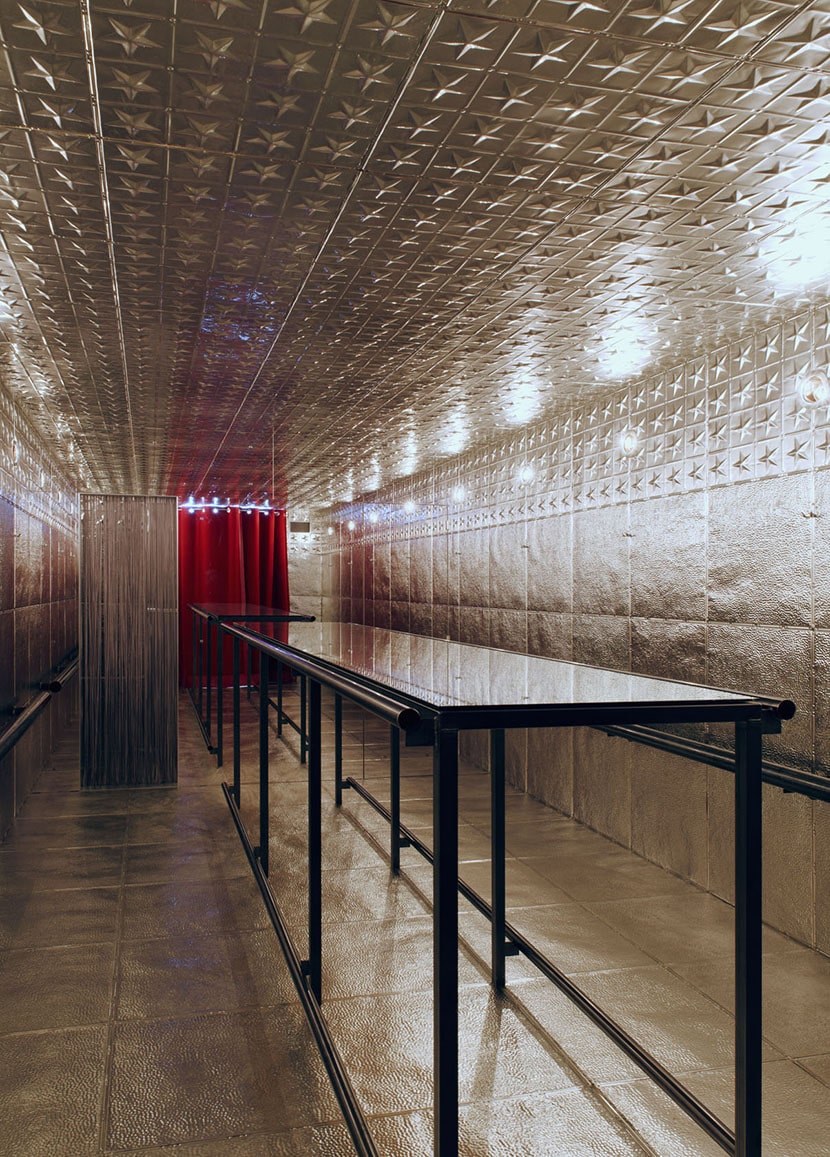
FL: Per quanto riguarda la serie dei disegni, sembra che tu voglia sottolineare la complessità del disegno formale in relazione ai caratteri specifici dando al titolo la funzione di evocare musicisti o protagonisti di storie famose che si chiamano Hans. È una traccia che vuole sensibilizzare sull’eccessiva semplificazione indotta dal design e anche un’apertura di un dibattito sulle nostre singole identità nel presente?
HS: Ho iniziato a disegnare la parola Hans a partire da ogni poster raccolto e questo percorso si è concluso con una serie di disegni di varie dimensioni e diversi caratteri tipografici, quindi direi che potrebbe essere un’appropriazione del mondo visivo tramite lo spostamento dell’attenzione. Posso essere trovato ovunque, quindi sono ovunque e tutto è me. Credo che questo sia qualcosa che è vero per tutti noi.
Arte e Critica, n. 82, estate 2015, pp. 96-99.
1. P. Fanego, Hans Schabus: The Space of Conflict, Verlag für moderne Kunst Nürnberg, Norimberga 2014, p.110.
HANS SCHABUS. RESEARCH AND SPATIAL-PERFORMATIVE DECLINATIONS OF BEING IN THE NAME
A space within the space, an area of 25 square meters, nearly 150 of posters and objects collected over fifteen years, a public bar open one day a week. Cafe Hansi is the latest project by Hans Schabus exposed to Kerstin Engholm Gallery in Vienna, on occasion of Autopsie mit Hubwagen.
A great space-sculpture houses the external heterogeneous forms of the name Hans, analogies and associations unify and disperse the identity of a common name and then almost disappeared. The interior is a bar, a “no place”, neutral and full of mirrors in which the artist serves the public.
Hans Schabus confirms and develops his approach, giving value to the space obtained inside another space, the possible and practicable, with the meticulous anticipation of a performative social sculpture. In our times along new and necessary social aggregations the Austrian artist’s work emphasizes the relationship between individuality that wants to investigate itself and a sociality in which it seeks to melt.
Francesco Lucifora: In your project Cafe Hansi a large sculpture and physical space shows two faces, it has an inside and an outside – on which a large number of different materials bearing reference to the name Hans – I’d like to know the reasons why you started to collect these materials and how this collection process has evolved?
Hans Schabus: Hans is a widely used name in Austria. I grew up in the countryside and there was at least one Hans in each family. After my generation this name became less interesting and wasn’t used anymore. If you search on the Internet for the name Hans only older people will show up. There are many fictive figures of Hans like Eisenhans, HansDampf, Hänsel and Gretel, Hans Guck-in-die-Luft, Hanswurst, Hans im Glück, like the silly Hans, the lazy Hans, the strong Hans, the dump Hans, the funny Hans etc. And if I am named after all these various Hanses I become part of all of them. Does that make any sense? So, I am a little bit of everything. I am the average of all possible Hanses. Probably that´s why I had to start a long time ago to collect materials with my name: to find out something about myself.
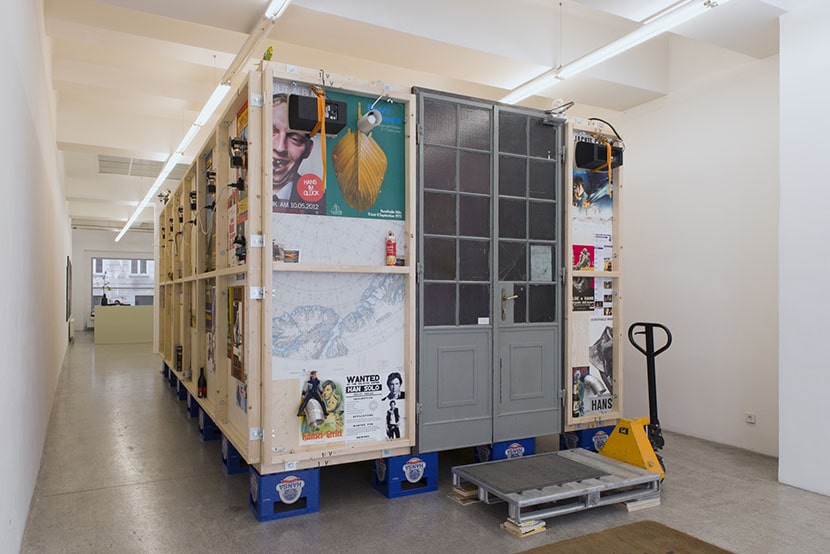
FL: A relevant part of your artworks relates to the relationship between your work studio and external reality to then claim a return to your studio. In Cafe Hansi there is a shift of this route, it seems to be an invitation into a more social space made of your identity but also an act of identity multiplication that erases perhaps the most self-centered of all human beings (ego). How did you come to this new sculptural space?
HS: The Cafe Hansi goes back to an exhibition I did with Secession in 2003. I constructed the volume of my studio at the end of a long tunnel. Because of a walled up entrance the visitors had to move downstairs. In the basement a tunnel started and led into the volume of the studio. The visitors were able to leave the space and finally entered the main exhibition hall of Secession, where they saw the back of the space they had walked through.
In general I am interested in a basic sculptural approach. Either assembling or taking away. In both ways you create volume. There’s the anecdote that when Michelangelo was asked how he made his lion figures, he said that he was merely chipping off the marble block that didn’t look like a lion. And this “inverted” thinking – where what’s missing becomes what truly matters – is what I’m interested in.
And after all: it’s great to host people. That´s why Cafe Hansi is becoming a performative, social sculpture.
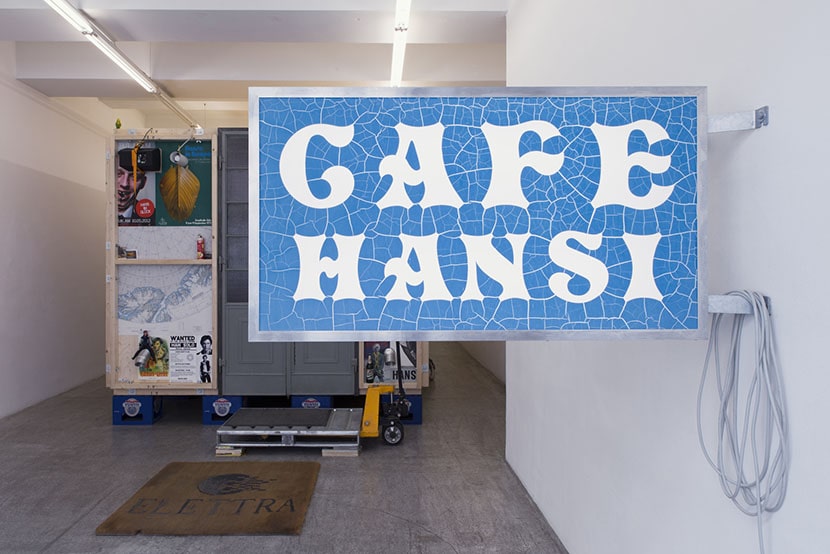
FL: Your way of understanding sculpture reserves often the presence of a duality space, I want to know what reasons are behind the sharp difference of inside and outside1 of this sculpture, the exterior is full of signs, sounds, references and associative mechanisms of Hans and the inside is linear, aseptic and offers to people the chance to see themselves in mirrors. I read this work as a high expression of the relationship thinking about individual and society. I’d like to ask you to tell me more about this.
HS: The actual exhibition space is divided by a membrane, a structure that consists of an inside and an outside. The outside shows all the physical, metaphorical, referential, and other materials. The inside is formed by a glossy surface and my presence as a waiter. The inside is open to the public only once a week after gallery hours. I wanted to create an inside that takes you into a so called nowhere-land. A place that has no physical connection although it is so physical.
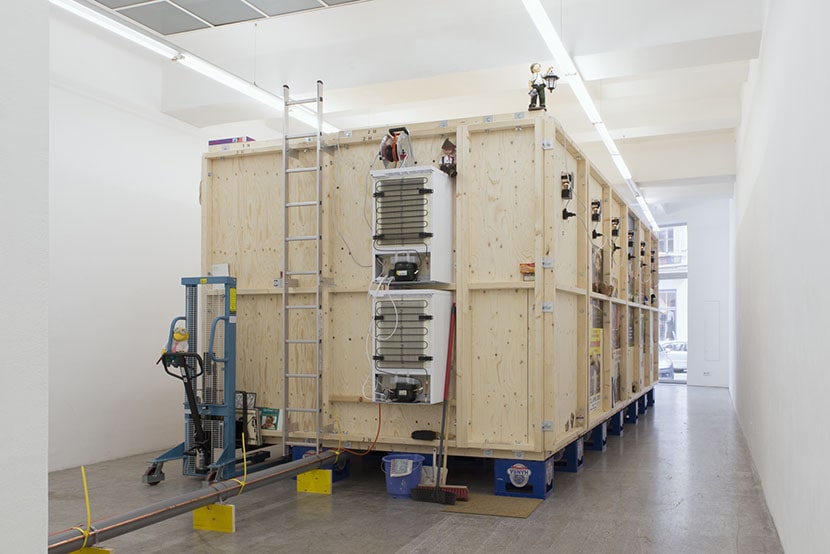
FL: Concerning the series of drawings, you underline the complexity of formal drawing in relation to specific lettering and you title these works with names of people like musicians or main characters of famous stories. Is this a path that wants to alert people about the oversimplification induced by “objects design”? Is this a way to open a debate about our single identities in the present?
HS: I was tracing the word Hans with each collected poster and ended up with a bunch of drawings in various sizes and typefaces and therefore it might be an appropriation of the visual world by shifting the focus. I can be found everywhere, so I am everywhere and everything is me. And this is something which is true for all of us.
Arte e Critica, no. 82, Summer 2015, pp. 96-99.
1. P. Fanego, Hans Schabus: The Space of Conflict, Verlag für moderne Kunst Nürnberg, Nuremberg 2014, p.110.


